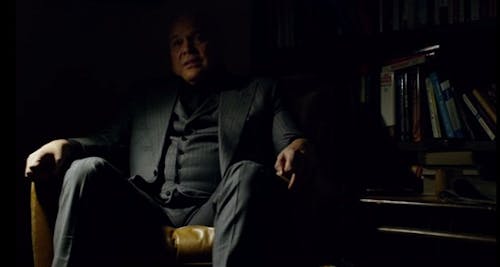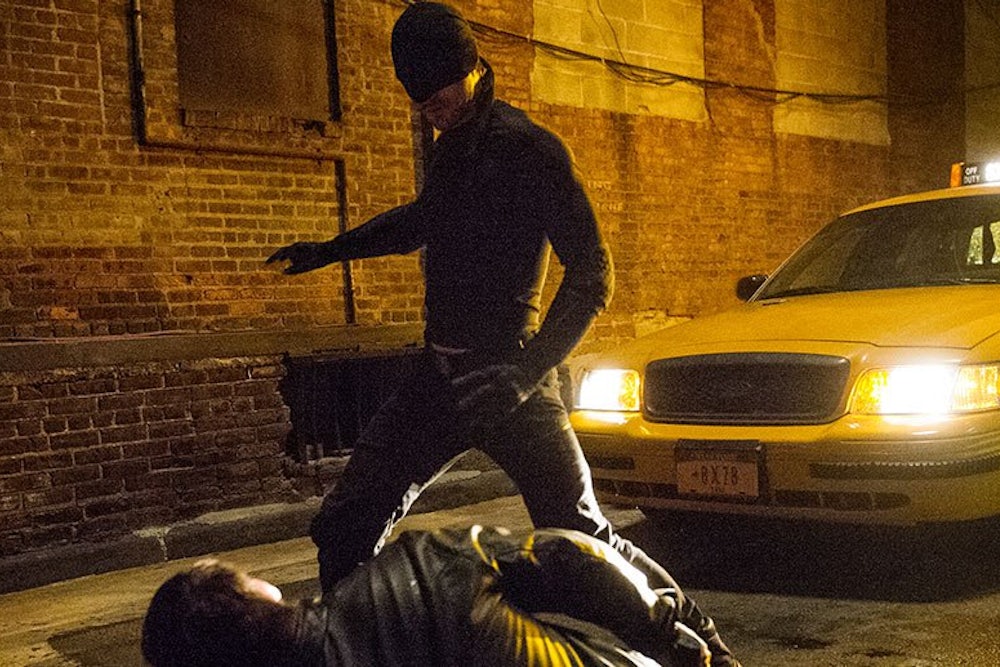Not all superheroes are created equal. Some caped champions—Superman springs to mind—save the world, or even the universe, as part of a routine day’s work. Other masked men work on a humbler scale. Their frame of reference is municipal rather than cosmic. They consider it a good night when they thwart a mugging.
Daredevil is perhaps the pre-eminent urban superhero. Unlike Batman of Gotham or the Flash of Central City or Green Arrow of Star City, Daredevil doesn’t zip around in an imaginary metropolis. Rather, Daredevil leaps from rooftop to rooftop, in a civic space that has a storied real-world history: Hell’s Kitchen in Manhattan.
This real-world setting of “Daredevil” gives the series—now available in 13 binge-ready episodes on Netflix—a special resonance. The Hell’s Kitchen of “Daredevil” is a formerly cohesive, white, working-class neighbourhood under pressure from a larger-than-life developer with glamorous redevelopment dreams. The real-life Hell’s Kitchen, has, like much of New York, experienced skyrocketing rents which have priced out the traditional inhabitants—working-class Irish immigrants.
“Daredevil,” adapted from the long-running Marvel comics franchise, is a superhero show about the evils of gentrification—a politically engaged work which is energized by debates about urban inequality. These debates are salient not only in the era of Mayor Bill de Blasio but also have roots deep in the city’s history.
The villain in Daredevil is Wilson Fisk, known as the Kingpin. Half-gangster and half-CEO, Fisk uses his vast resources, licit and illicit, to reshape the gritty Hell’s Kitchen that he remember from his youth, into a swanky locale more suitable for his rich pals, including his gallery-owning girlfriend and a Wall Street bigwig. Arrayed against Fisk is the masked vigilante Daredevil—a lawyer by day who becomes a masked avenger at night, armed with little more than a few extra-sensory powers and some martial arts skills used to beat up on Fisk’s mobster friends—and a ragtag band of strikingly working-class characters: the legal secretary Karen Page, the nurse Claire Temple, the tabloid crime reporter Ben Urich, and a Hispanic immigrant named Elena Cardenas who is being squeezed out of her rent-controlled apartment.
The characters in the series are sharply aware of the class-war dimensions of their struggle. As Karen notes, the villains “are trying to strong-arm people like Elena so they can sweep their homes away from them and build condos no one can afford.” Urich, the reporter, writes a blistering column describing the New York that Fisk rules over: “Some get more than they deserve. Because they believe they aren’t like everyone else, that the rules, the ones people like me and you, the people that work and struggle to live our lives, just live, don’t apply to them. That they can do anything and live happily ever after, while the rest of us suffer.” He continues, referring to the fatigue that has set in among his cohort in their struggle to “claw our way back to a middle class that no longer exists.” He pulls the column before it can go to press, but he doesn’t abandon the sentiment.
What lifts the show above the level of socialist realist melodrama is the somewhat sympathetic portrayal of Fisk (brought to life with a shy dignity and subdued menace by the actor Vincent D’Onofrio). A native of Hell’s Kitchen, he has no nostalgia for the violence of neighbourhood; he wishes to bring his expensive tastes in food, clothing, and food to the crime-ridden district. As he explains to his refined girlfriend, Vanessa Marianna: “I want to carve something beautiful out of its ugliness, set free its potential,” he contends. “I’m just a man with a dream.”
In a crucial scene near the end of the season, Fisk intrudes in the home of the reporter, Urich. Sitting in front of an over-crammed bookshelf, one tome's thick, white spine is notably visible behind Fisk: Robert Caro’s The Power Broker (1974), a Pulitzer Prize-winning biography of the polarizing urban planner Robert Moses.

The visibility of Caro’s book is no accident. Wilson Fisk is Robert Moses re-imagined as a super-villain. Like Moses, a dominant figure in mid-twentieth century urban planning, Fisk is an overbearing visionary whose utopian dream displaced the working poor; both Moses and Fisk embody the hubris of high-modernist urban planning. Moses’s zeal to connect the city with parkways and overpasses led to the destruction of many working-class neighborhoods, with African American and Puerto Rican communities bearing the brunt. After running roughshod over New York for decades, Moses famously met his match in the populist activist Jane Jacobs, who fought for urban policies that respected the integrity of existing communities. In “Daredevil,” the Jane Jacobs-stand in wears a mask.
Any long-running superhero franchise ends up acquiring many archeological layers of anachronisms. But this echo of 1960s urban battles underlines the peculiar genesis of this series. “Daredevil” was created as a comic book series in 1964 by Stan Lee and Bill Everett. For many years it hobbled along as a second-string title, a knock-off that mixed elements of Spider-Man and Batman. The series was revitalized in the late ’70s and early ’80s by cartoonist Frank Miller, who gave it the gritty noir ambience and macho masochism (evident in his ability to endure pain) that the Netflix series appropriates. Miller also gave prominence to Daredevil’s Catholicism—this is a superhero who goes to confession and chalks up his resiliency in taking beatings to his upbringing as a Catholic man.
The long genesis of this series has resulted in some additional oddities. Daredevil’s real life identity is Matt Murdock, a blind lawyer whose father was an Irish-American boxer who lived in Hell’s Kitchen and is pressured by the mob to take a fall for money. This Irish boxer–type might have been semi-plausible in the early ’60s—although, even then it was based on stereotypes found in earlier movies like On the Waterfront. In 2015, the cohesive, white working-class Hell’s Kitchen portrayed in “Daredevil” seems jarringly unreal, set as it is in a city with a far more diverse working class.
If these ham-fisted attempts to retrofit the past into the present dilute “Daredevil” as a commentary on our time, they do give the series a deeper historical resonance. It is easy to think of urban inequality as a pressing concern hotly debated under the rule of Michael Bloomberg and Bill de Blasio. By turning Robert Moses into a larger-than-life monster, “Daredevil” reminds us that battles over gentrification are part of a longer struggle to make a livable city for working-class citizens. In the ’60s, we looked to brave figures like Jane Jacobs to stand up for the villages and communities that exist within cities. Now, our hopes lie with the likes of Daredevil, whose influence registers only in comic books and on the small screen.
